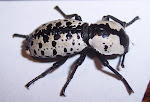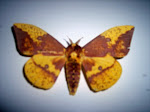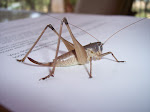Issue 4 - August 1, 2009 Carolina Anole
Well…… Good Morning neighbors! The coffee is on and dawn will be breaking soon. It’s a little cooler too. It doesn’t get much better than what we have here in Mystic Shores, but yesterday afternoon Mother Nature added a little extra. We finally got a decent rain and the local wildlife has a little reprieve.
Let’s talk about contemporary little dinosaurs this morning, and I don’t mean that type that sells insurance on TV. Certainly one of the most common little lizards around Mystic Shores is that bright green little fellow that was hanging around my back porch yesterday. I’m sure you have all seen the ones I’m talking about. They chase bugs, do ‘push-ups’ on the patio furniture, and often display a colorful throat patch. This little fellow is most commonly called the Carolina Anole and he’s a fascinating and fun little creature to watch.
(Kingdom; Animalia, Phylum; Chordata, Class; Reptilia, Order; Squamata, Family; Polychrotidae, Genus: Anolis, Species: A. Carolinensis)
These arboreal little reptiles have a number of common names, including the Green Anole, American Anole, Red-throated Anole and the American Chameleon (although it is not a true chameleon).
The Carolina Anole thrives throughout the Southeast part of our wonderful country, particularly in the coastal plain and, here in Texas, can be found throughout the Hill Country and east to the Gulf (of course our Texas species is the biggest and best).
The bright green coloration is obviously a great benefit while hiding from predators and prey alike in the foliage. However, it does have the capability to change color when the conditions warrant, hence the reference to the chameleons. Interestingly, their coloration is often dependent on their temperature as much or more-so than their background. When the temperature is 70 degrees or higher, they normally keep their green color. When it is cooler, they turn brown. Perhaps this is a trait that the species has developed over the millennia so that they better match their surroundings during the winter months. Regardless, their color is triggered by changes in their hormone (intermedin) levels secreted by their pituitary gland. They can also change colors if they are stressed out, nervous or possibly ill.
These little (5-7 inches in length) neighbors are active during the day and can often be seen running around in the garden or in areas where they might find insects. They are good climbers and can go up and down trees and walls without any problem. I think that the insects that are attracted to our porch lights during the evenings make for a good breakfast for the Anoles the following day. Anoles will eat crickets, beetles, moths, flies and grasshoppers. They don’t chew their food so they will stuff these bugs in their mouths and swallow them whole. Of course, these small lizards must be careful because many birds will make a breakfast of them, if they get the chance.
More often than not, the ones you see on your porch will be the males and their courtship period will last from April into September. The boys can be quite brazen for such a small fry and certainly take some chances. The male of this species are very territorial and will protect their turf against all rivals. One reason for the display of the red throat skin (called a ‘dewlap’) is to warn off competing males. Often this is in combination with an aggressive bobbing up and down (like push-ups). It’s also possible that this bobbing gives them better depth perception when they spot something. The other reason for inflating their dewlap is to attract females.
If their displays are successful in enticing a willing female, she will start laying little white eggs, one at a time, in about two weeks. She lays her dozen or so eggs in moist places like rotten logs or forest floor litter. After an incubation period of about six weeks, the baby Anoles hatch and immediately must fend for themselves. The parents have no role in raising the kids.
As the young Anoles grow to their full size of 5-7 inches, they will molt occasionally and often eat the shed skin. They are also reportedly very susceptible to pesticides that are ingested with their insect prey. If you spray pesticides around your yard, you probably won’t have too many Anoles around.
In the wild, the males have a life span of about two years and the females somewhat longer. Often, you will see an Anole that is missing a piece of tail or perhaps even has a wound on its side or leg, which is most likely from an encounter with a bird. One habit that Anoles have while hunting is to perch upside down on a tree trunk or wall with their tail hanging out in the air, swinging back and forth like a cat’s. This makes an easy target for birds in the vicinity.
Anoles can grow new tails but the new tail doesn’t have bones, and is often kinked and brownish in color.
Anoles actually make good pets, and have been known to live up to seven years in captivity. Care must be taken to feed them insects that are pesticide free, however. Their overall health in captivity can be gauged by their color. The greener, the healthier!
Anoles are harmless to humans and pets, although they will probably try to give you a pinch if you handle one improperly.
So, the next time you see a gecko on TV selling Geico Insurance, remember that we have a close cousin living amongst us here in Mystic Shores, and that he is a fascinating little member of our neighborhood!
Clay
Click on these pictures to go directly to the article.
Followers
Blog Archive
About Me

- Clay Crum
- I'm always looking for suggestions (or photos) about other Mystic Shore wildlife. Do you know where a rattlesnake den is located? Do you have pictures of a mountain lion taken locally? Have you had interesting encounters with our wildlife? Share them with me by sending me an email or commenting on this blog.













